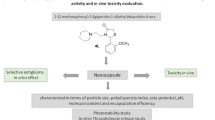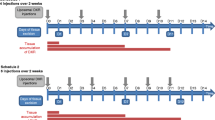Abstract
Epirubicin (EPI) has strong cytotoxic activity that makes it a potential candidate for the treatment of malignant gliomas. To minimize toxicity and increase CNS penetration, EPI was incorporated into biodegradable polymers, and its in vitro and in vivo properties were studied. 9L, F98, C6, U251, and EMT-6 cell lines were treated with EPI in vitro and cell viability was measured. Toxicity of EPI/polycarboxyphenoxypropane-sebacic-acid (pCPP:SA) polymers was tested in vivo using F344 rats intracranially implanted with EPI polymers (2–50% by weight). The efficacy of 50% EPI:pCPP:SA polymers was determined in F344 rats intracranially challenged with 9L and treated either simultaneously or 5 days after tumor implantation. The efficacy of 50% EPI:pCCP:SA polymers administered on Day 5 in combination with oral TMZ was determined in rats intracranially challenged with 9L gliosarcoma. EPI was cytotoxic in all cell lines used in vitro. Intracranial implantation of the EPI polymers in rats generated neither local nor systemic toxicity. Animals receiving intracranial EPI on Day 5 had 50% long-term survivors (LTS), which was superior to local EPI delivered on Day 0 (LTS = 12.5%). Animals receiving intracranial EPI in combination with oral TMZ had 75% LTS whereas no other group had LTS. In those EPI treated animals that died before the controls there was evidence of intracranial hemorrhage. Systemic epirubicin resulted in high toxicity levels and early deaths in all the experiments. EPI polymers, alone or in combination with oral TMZ, is an effective therapeutic modality against experimental 9L gliosarcoma.










Similar content being viewed by others
References
Chang SM, Parney IF, Huang W, Anderson FAJ, Asher AL, Bernstein M, Lillehei KO, Brem H, Berger MS, Laws ER (2005) Glioma outcomes project investigators patterns of care for adults with newly diagnosed malignant glioma. JAMA 293:2469–2470
Attenello FJ, Mukherjee D, Datoo G, McGirt MJ, Bohan E, Weingart JD, Olivi A, Quinones-Hinojosa A, Brem H (2008) BCNU wafer in surgical treatment of glioma. Ann Surg Oncol 15:2887–2893
Gururangan S, Cokgor L, Rich JN, Edwards S, Affronti ML, Quinn JA, Herndon JEn, Provenzale JM, McLendon RE, Tourt-Uhlig S, Sampson JH, Stafford-Fox V, Zaknoen S, Early M, Friedman AH, Friedman HS (2001) Phase I study of gliadel wafers plus temozolomide in adults with recurrent supratentorial high-grade gliomas. Neuro Oncol 3:246–250
La Rocca R, Vitaz TW, Villanueva W, Hodes J, Cervera A, New P, Litofsky N (2008) A phase 2 study of multi-modal therapy with surgery, carmustine (BCNU) wafer, radiation therapy (RT), and temozolomide (TMZ) in patients (PTS) with newly diagnosed supratentorial malignant glioma (MG). In: 8th Congress of the European association of neurooncology. Barcelona, Spain
McGirt MJ, Than KD, Weingart JD, Chaichana KL, Attenello F, Olivi O, Laterra J, Kleinberg LR, Grossman SA, Brem H, Quinones-Hinojosa A (2008) Gliadel (BCNU) wafer plus concomitant temozolomide therapy after primary resection of glioblastoma multiforme. J Neurosurg 110:583–588
Menei P, Metellus P, Loiseau H, Capelle L, Jacquet G, Guyotat J (2008) Biodegradable carmustine-impregnated wafers (gliadel®): the French experience. In: 8th Congress of the European Association of Neurooncology. Barcelona, Spain
Parney IF, Chang SM (2003) Current chemotherapy for glioblastoma. Cancer J 9:149–156
Rautioa J, Chikhale PJ (2004) Drug delivery systems for brain tumor therapy. Curr Pharm Des 10:1341–1353
Tokudome N, Ito Y (2006) Adjuvant chemotherapy based on evidence-based medicine for breast cancer patients. Gan To Kagaku Ryoho 33:318–323
Hirano A, Shimizu T, Imamura H, Watanabe O, Kinoshita J, Okabe T, Kimura K, Kamimura M, Domoto K, Aiba M, Ogawa K (2006) The combination of epirubicin plus docetaxel as neoadjuvant chemotherapy in locally-advanced breast cancer. Anticancer Res 26:581–584
Wagner AD, Grothe W, Haerting J, Kleber G, Grothey A, Fleig WE (2006) Chemotherapy in advanced gastric cancer: a systematic review and meta-analysis based on aggregate data. J Clin Oncol 24:2903–2909
Jensen BV (2006) Cardiotoxic consequences of anthracycline-containing therapy in patients with breast cancer. Semin Oncol 33:S15–S21
Bigotte L, Olsson Y (1989) Distribution and toxic effects of intravenously injected epirubicin on the central nervous system of the mouse. Brain 112:457–469
Westphal M, Hilt DC, Bortey E, Delavault P, Olivares R, Warnke PC, Whittle IR, Jääskeläinen J, Ram Z (2003) A phase 3 trial of local chemotherapy with biodegradable carmustine (BCNU) wafers (gliadel wafers) in patients with primary malignant glioma. Neuro Oncol 5:79–88
Brem H, Piantadosi S, Burger PC, Walker M, Selker R, Vick NA, Black K, Sisti M, Brem S, Mohr G (1995) Placebo-controlled trial of safety and efficacy of intraoperative controlled delivery by biodegradable polymers of chemotherapy for recurrent gliomas. The polymer-brain tumor treatment group. Lancet 345:1008–1012
Brem H, Ewend MG, Piantadosi S, Greenhoot J, Burger PC, Sisti M (1995) The safety of interstitial chemotherapy with BCNU-loaded polymer followed by radiation therapy in the treatment of newly diagnosed malignant gliomas: phase I trial. J Neurooncol 26:111–123
Valtonen S, Timonen U, Toivanen P, Kalimo H, Kivipelto L, Heiskanen O, Unsgaard G, Kuurne T (1997) Interstitial chemotherapy with carmustine-loaded polymers for high-grade gliomas: a randomized double-blind study. Neurosurgery 41:44–48
Westphal M, Ram Z, Riddle V, Hilt D, Bortey E, Group ECotGS (2006) Gliadel wafer in initial surgery for malignant glioma: long-term follow-up of a multicenter controlled trial. Acta Neurochir (Wien) 148:269–275
Stupp R, Mason WP, van den Bent MJ, Weller M, Fisher B, Taphoorn MJ, Belanger K, Brandes AA, Marosi C, Bogdahn U, Curschmann J, Janzer RC, Ludwin SK, Gorlia T, Allgeier A, Lacombe D, Cairncross JG, Eisenhauer E, Mirimanoff RO (2005) European organisation for research and treatment of cancer brain tumor and radiotherapy groups; national cancer institute of Canada clinical trials group radiotherapy plus concomitant and adjuvant temozolomide for glioblastoma. N Engl J Med 352:987–996
Mosmann T (1983) Rapid colorimetric assay for cellular growth and survival: application to proliferation and cytotoxicity assays. J Immunol Methods 65:55–63
Fountzilas G, Kalofonos HP, Dafni U, Papadimitriou C, Bafaloukos D, Papakostas P, Kalogera-Fountzila A, Gogas H, Aravantinos G, Moulopoulos LA, Economopoulos T, Pectasides D, Maniadakis N, Siafaka V, Briasoulis E, Christodoulou C, Tsavdaridis D, Makrantonakis P, Razis E, Kosmidis P, Skarlos D, Dimopoulos MA (2004) Paclitaxel and epirubicin versus paclitaxel and carboplatin as first-line chemotherapy in patients with advanced breast cancer: a phase iii study conducted by the hellenic cooperative oncology group. Ann Oncol 15:1517–1526
Schott B, Robert J (1989) Comparative activity of anthracycline 13-dihydrometabolites against rat glioblastoma cells in culture. Biochem Pharmacol 38:4069–4074
Schott B, Robert J (1989) Comparative cytotoxicity, DNA synthesis inhibition and drug incorporation of eight anthracyclines in a model of doxorubicin-sensitive and -resistant rat glioblastoma cells. Biochem Pharmacol 38:167–172
Neidle S, Sanderson MR (1983) The interactions of daunomycin and adriamycin with nucleic acids. In: Neidle S, Waring MG (eds) Molecular aspects of anticancer drug action. Verlag Chemie, Weinheim, pp 33–55
Glisson BS, Ross WE (1987) DNA topoisomerase II: a primer on the enzyme and its unique role as a multidrug target in cancer chemotherapy. Pharmacol Ther 32:89–106
Sinha BK, Katki AG, Batist G, Cowan KH, Myers CE (1987) Differential formation of hydroxyl radicals by adriamycin in sensitive and resistant MCF-7 human breast tumor cells: implications for the mechanism of action. Biochemistry 26:3776–3781
Tritton TR, Yee G (1982) The anticancer agent adriamycin can be actively cytotoxic without entering cells. Science 217:248–250
Lesniak MS, Upadhyay U, Goodwin R, Tyler B, Brem H (2005) Local delivery of doxorubicin for the treatment of malignant brain tumors in rats. Anticancer Res 25:3825–3831
Mamot C, Drummond DC, Noble CO, Kallab V, Guo Z, Hong K, Kirpotin DB, Park JW (2005) Epidermal growth factor receptor-targeted immunoliposomes significantly enhance the efficacy of multiple anticancer drugs in vivo. Cancer Res 65:11631–11638
Gallia GL, Brem S, Brem H (2005) Local treatment of malignant brain tumors using implantable chemotherapeutic polymers. J Natl Compr Canc Netw 3:721–728
Legnani FG, Pradilla G, Wang PP, Brem H, Olivi A, DiMeco F (2003) Local delivery of antineoplastic agents using biodegradable polymers for the treatment of malignant brain tumors. Expert Rev Neurother 3:533–546
Stupp R, Dietrich PY, Ostermann Kraljevic S, Pica A, Maillard I, Maeder P, Meuli R, Janzer R, Pizzolato G, Miralbell R, Porchet F, Regli L, de Tribolet N, Mirimanoff RO, Leyvraz S (2002) Promising survival for patients with newly diagnosed glioblastoma multiforme treated with concomitant radiation plus temozolomide followed by adjuvant temozolomide. J Clin Oncol 20:1375–1382
Soffietti R, Rudà R, Trevisan E (2007) New chemotherapy options for the treatment of malignant gliomas. Anticancer Drugs 18:621–632
Author information
Authors and Affiliations
Corresponding author
Rights and permissions
About this article
Cite this article
Recinos, V.R., Bekelis, K., Ziegler, S.G. et al. Epirubicin exhibits potent anti-tumor activity in an animal model of malignant glioma when administered via controlled-release polymers. J Neurooncol 97, 1–10 (2010). https://doi.org/10.1007/s11060-009-9984-3
Received:
Accepted:
Published:
Issue Date:
DOI: https://doi.org/10.1007/s11060-009-9984-3




